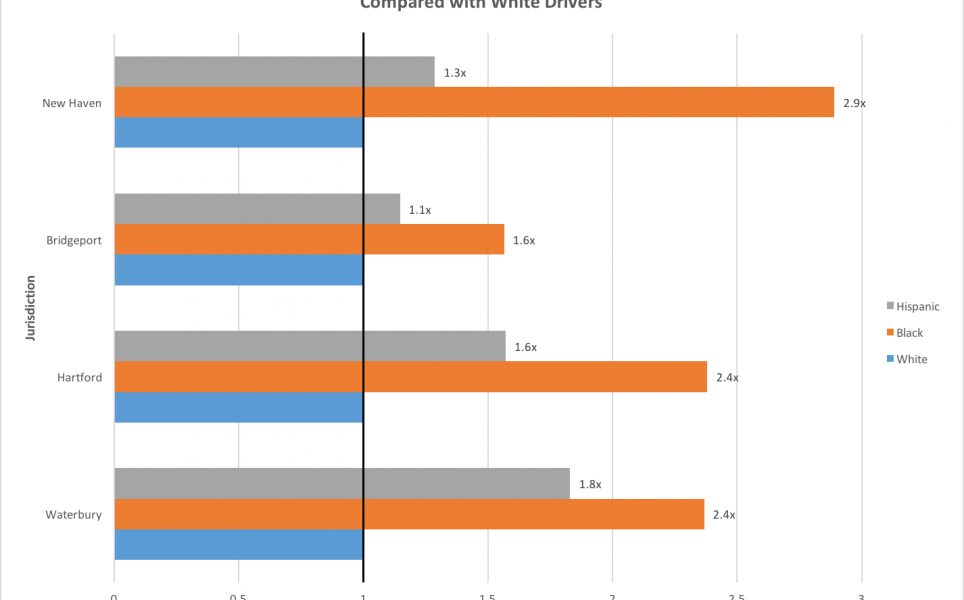BY CAMILLE SEABERRY
[Note: This article/op-ed was originally posted in the New Haven Independent on August 2, 2016. http://www.newhavenindependent.org/index.php/archives/entry/bail_reform1/]
With little fanfare, Connecticut’s Department of Correction recently began releasing data on its pretrial jail population, updated daily beginning July 1, 2016. Inmates are given an anonymous ID, and the dataset logs their age, race, gender, offense, facility, and bond amount. Analysis of the data would illuminate trends over time, possible disparities, and patterns in the amount of bond assigned by offense and race.
While the data released so far only covers a short period of time, TrendCT posted a preliminary look at who is in pretrial detention, for how long, and on what charges. As more data is released, our understanding of the pretrial population will become more robust.
Why is data on pretrial detention so important?
Targeting pretrial detention — and the barriers many communities face in being released from detention — may move the needle toward ending mass incarceration. In recent years, the crisis of mass incarceration in the U.S. has seen mainstream acceptance pushed by new, diverse allies. Once a fringe topic, mass incarceration is now acknowledged inbest-sellers, bipartisan legislation, and White House data initiatives.
Often, what greets a person entering the criminal justice system is a bail amount they cannot hope to pay. While prison rates have stalled and begun to decrease slightly for people convicted of and sentenced for crimes, a high—and increasing — number of people are detained in jails without having yet been convicted. Many of these people have cycled repeatedly in and out of jail, and are being charged only with nonviolent misdemeanors. African-Americans and Latinos are held in pretrial detention at much higher rates than white people.
There is even evidence that the length of time spent in detention before trial may predict whether a person is sentenced to prison and for how long. There is also a growing movement toward more data-driven practices within criminal justice systems, such as risk assessments, though this is not without its concerns of bias.
In Connecticut, Gov. Malloy’s administration launched its Second Chance Society initiative, signed into law in 2015, to decrease both incarceration and crime rates; a second set of proposals not yet passed into law targets bail and pretrial detention. The state also received a grant from the Safety and Justice Challenge to reduce its jail population, expand diversion programs, and evaluate racial disparities. Having data available on the pretrial population can help lawmakers identify areas for reform in these initiatives. Notably, in the current sample of data, the most common offense for which bond was set for both men and women is violation of probation or conditional release, an area that has already been marked for possible reform measures.
While the Second Chance 2.0 bill failed to pass this year, Connecticut has built momentum toward some degree of bail reform. One promising new example, the Yale-supported Connecticut Bail Fund, is raising money to post bail for people in need. Many of the Second Chance reforms have found support from New Haven’s City Hall and representatives.
Though the amount of pretrial data available is still small, with only a few weeks’ entries, we can find some information about New Haven. On any given day since July 1, the New Haven Correctional Center (NHCC) has an average of 540 men in pretrial detention, lower than the state’s other two Correctional Centers in Hartford and Bridgeport, but higher than other facilities. (Note that inmates at NHCC are not necessarily New Haven residents, and vice versa.) As is true for the state, the most common offense for which bond was set is violation of probation or conditional discharge. As more data becomes available, it will be possible to see whether patterns at NHCC mirror those of the state, what bail amounts are typical at NHCC, and what role New Haven might play in the bail reform movement.
The state’s pretrial data will allow us to ask better questions — How do bail amounts vary for the same offense? How long do people stay in jail, and is that affected by bail amount? How do young adults fare? — and seek more nuanced answers.
As with other criminal justice issues, data leading to an in-depth understanding of pretrial detention and bail amounts will fuel a stronger, better informed reform movement in our state.
Camille Seaberry is Research Assistant at DataHaven, a formal partner of the National Neighborhood Indicators Partnership with a 25-year history of public service to Greater New Haven and Connecticut. DataHaven’s mission is to improve quality of life by collecting, sharing and interpreting public data for effective decision making.
Link:
http://www.newhavenindependent.org/index.php/archives/entry/bail_reform1/









